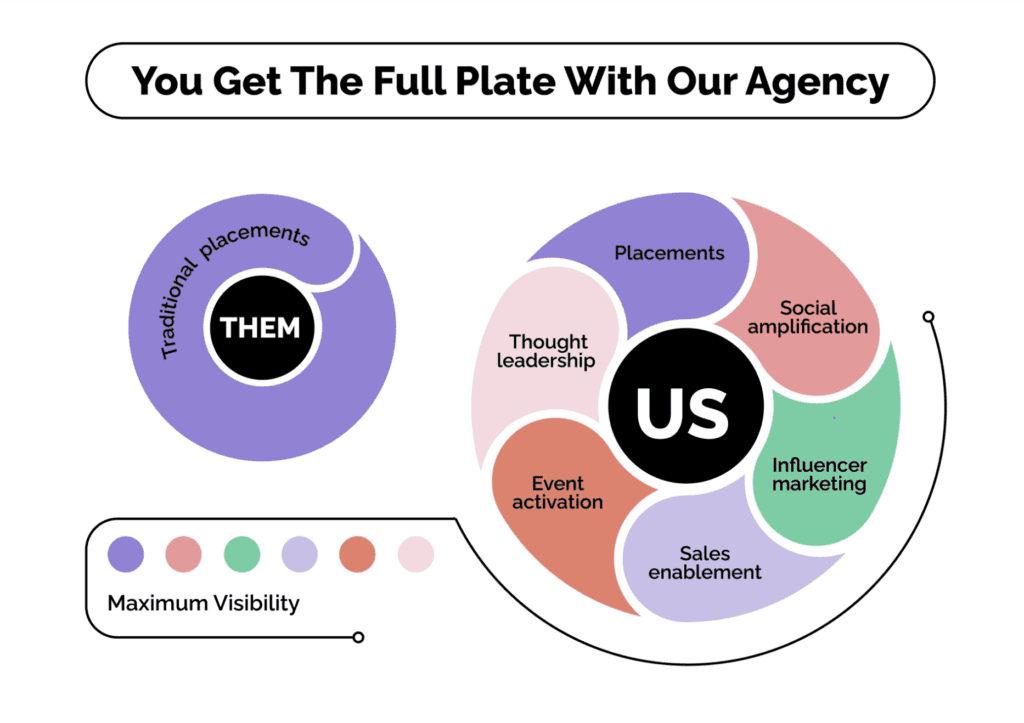A lot of people think PR and marketing are two different things. And while they each have their distinctions and nuances, a successful, holistic marketing strategy always involves both.
Marketing and PR need to work together for businesses to truly be successful.
PR helps create brand awareness and visibility by getting your story to the masses, and it builds brand authority by placing your brand or your spokespeople in reputable publications.
Marketing involves defining your brand, determining your target audience segments, and using various strategies to make touchpoints with potential prospects.
So when you’re trying to figure out if you’re getting enough PR coverage, look at the marketing goals that your PR plan is helping you achieve—specifically, is the PR coverage you’re getting reaching the audience you’re targeting?
Here are a few questions you should be asking yourself:
Is your brand being featured or mentioned in the media that investors, customers, and partners are seeing?
If you’re not reaching your target audience, your marketing and PR efforts need to be reevaluated.
Reaching your target audience doesn’t mean you’re reaching as many people as possible—it means you’re reaching the right people. Your investors, current customers, and future customers all have certain patterns of behavior that marketing and PR efforts can come together to analyze, predict, and reach.
With this data, your PR team should be able to identify where your target audience gets its media, and they shouldn’t limit this investigation to traditional news publications. Digital PR means looking beyond newspapers and magazines to include blogs, podcasts, livestreams, and more. Once your PR team gets hits—whether in traditional publications or otherwise—they need to make sure that the target audience sees them.
In PR of old, publicists and the companies they worked for had very little control over what their audience saw. Once a piece was published, people either saw it and took notice or they didn’t, and that was that. Now, in the time of social media, an important part of PR is bringing the news to the audience. We do this through social media amplification, having a press page on your company website, and by weaving press hits into other content—like linking to a press hit on the company blog.
Modern PR doesn’t stop at getting the hit; that’s where the real work starts. It’s through amplifying PR hits and making sure the right people see it that PR really impacts the sales funnel. We call this sales-enabled PR.
How do you compare to your competitors when it comes to media coverage?
An important way to determine if you’re getting the PR results you need to move the needle for your company is by tracking your Share of Voice(SOV).
Share of Voice, in a nutshell, is the share of the market that your brand owns. Think about it this way—if someone talks about athletic shoes, what shoe company do you think of?
Nike? Addidas? Reebok? Most likely, one of those crossed your mind, and that’s because these brands how the largest share of voice.
The companies that are most visible—those with the highest SOV—are the ones that people trust. After all, Nike wouldn’t sell millions if they didn’t have one of the best products on the market, right? And that credibility brought on by visibility (SOV) leads to profitability.
But it isn’t just SOV that builds credibility—it’s also getting the right type of placements. If you’re getting mentions in the National Enquirer while your competitors are getting bylines in Forbes, odds are they’re going to come across as more credible. (Unless, of course, your company is about investigating the paranormal or finding evidence that Elvis is, in fact, alive.)
A series of strong placements in relevant industry publications and other trusted media sources will build your brand’s trustworthiness and authority. This will not only help you gain SOV in your industry—it will also ensure that the messaging around your SOV places you as a frontrunner in the industry.
Are you in key industry publications and in ongoing conversations regarding industry trends?
A lot of traditional PR agencies focus on sending our press releases and communicating the goings-on of your business. This is all well and fine, but it doesn’t always lead to exciting press or strong engagement. Strong PR teams go beyond announcing your new product, CEO, or funding round. They tie your business’s news to the trends and conversations of your industry and of society at large.
This not only creates engaging press—but it also places you at the center of these conversations. When you or your business sit at the center of a hot conversation or topic, it compels the media to seek you out.
As we say at Zen: press begets press. The more your PR agency can make you an important thought leader in the industry, the more publications will cover your company’s news organically and ask for your insights on new trends and topics.
So, is your PR agency getting you enough coverage?

If you’re answering no to one or more of the questions in this blog, it’s time to talk to your agency and reevaluate your efforts. Make sure that they know what your goals are, and ask them how they plan to achieve those goals.
PR hits don’t happen overnight, so give your agency a little time to get to know your brand and build relationships with relevant publications, podcast hosts, and more before you panic.
But, truth is, if you aren’t seeing results after a few months, that’s a problem.
Need help getting those hits and moving the needle? Let’s talk.





